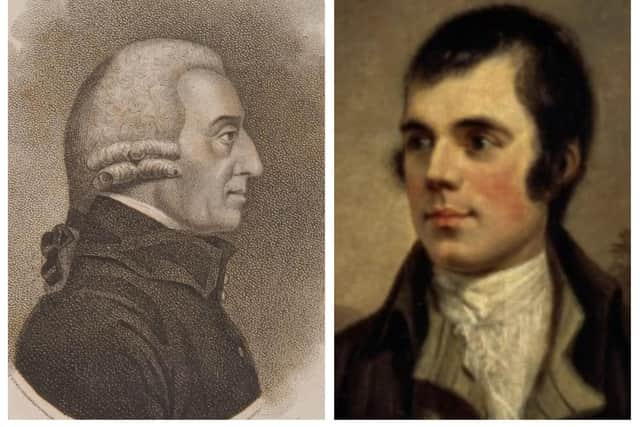Robert Burns, Adam Smith and the mutual regard of two Scottish giants
Now, the influence that Adam Smith had on the work of Robert Burns is being explored by scholars from Glasgow University who are set to examine how the moral philosopher, economist and once rector of the institution helped to support and inspire the work of the poet.
Dr Ronnie Young, senior lecturer of Scottish Literature and Dr Craig Smith, Adam Smith senior lecturer in the Scottish Enlightenment, will use several of Burns most familiar works to illustrate Smith’s influence on the poet at at the Global Burns free online event on Tuesday.
Advertisement
Hide AdAdvertisement
Hide Ad“Burns is doing in poetry what Smith is doing in philosophy,” Dr Young said.


Although they didn’t meet in person, it is known Smith held the poet in regard and subscribed to four editions of the Edinburgh edition of Poems, Chiefly in Scottish Dialect, published in 1787. The collection contains works including To a Mouse and To a Louse, both which directly draw from Theory of Moral Sentiments, which Smith published almost 30 years earlier.
A letter to Burns from a mutual friend also shows Smith, whose tercentenary is being celebrated by the university this year, wanted to meet Burns and took “most interest” in his future prospects. Meanwhile a handwritten note in the poet’s commonplace book, now on show at the Robert Burns Birthplace Museum in Alloway, said he had read the “most excellent” Theory of Moral Sentiments.
Dr Young added: “The Theory of Moral Sentiments came up with this idea that our morality is founded in what Smith called sympathy, which is more like the modern sense of empathy, He believed this sentiment of sympathy was key to morality.”
These ideas started to inform a new style of sentimental literature in the 18th Century, which Burns was “nuts for”.
Dr Young added: “Smith has a great influence on that type of literature but he is also a great influence on Burns, his early work particularly.”
To a Mouse draws directly on the notion of sympathy with the poet, then a tenant farmer, putting himself in the place of the mouse after its nest is destroyed in a field, leaving it without a home for winter.
Meanwhile, To A Louse explores Smith’s theory of “impartial spectator” where people check their own morality through the eyes of others. It directly draws on Smith with the famous line “O wad some Pow’r the giftie gie us’, To see oursels as others see us!’.Smith, considered the father of modern economics following publication of Wealth of Nations in 1776, was also promoting literary culture in Scotland through various societies when Burns came on the scene, Dr Smith said.
Advertisement
Hide AdAdvertisement
Hide AdHe added: “Burns becomes a celebrity, somebody who is a native poet somebody who is being recognised as being very gifted. It strikes me that Smith, even before he read any Burns, would have been curious about this person.”
“Often the people that Burns talks about are quite ordinary people, they are not heroic, and that is what Smith is interested in aswell. He is not interested in martyrs, and kings and that kind of thing. He is interested in how everyday people learn to be decent people and that, I think, is another shared area of interest.”